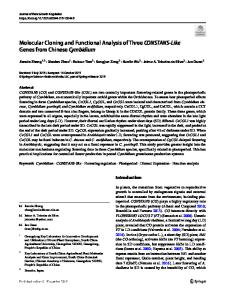Functional analysis of promoter sequences of cephalosporin C biosynthesis genes from Acremonium chrysogenum : specific D
- PDF / 407,514 Bytes
- 11 Pages / 595 x 785 pts Page_size
- 59 Downloads / 260 Views
O R I GI N A L P A P E R
E. K. Schmitt á R. Kempken á U. KuÈck
Functional analysis of promoter sequences of cephalosporin C biosynthesis genes from Acremonium chrysogenum : speci®c DNA-protein interactions and characterization of the transcription factor PACC Received: 23 August 2000 / Accepted: 7 December 2000 / Published online: 21 February 2001 Ó Springer-Verlag 2001
Abstract An analysis of the pcbC promoter from the cephalosporin C-producing ®lamentous fungus Acremonium chrysogenum was performed using fungal transformants carrying reporter gene fusions. By investigating sequential deletion derivatives of the pcbC promoter region, a DNA fragment was identi®ed, which is responsible for transcriptional activation of the pcbC gene. Sequence analysis of this fragment revealed a consensus binding site for the fungal transcription factor PACC. Gel-retardation experiments with crude extracts of A. chrysogenum con®rmed the speci®c binding of a protein to the PACC binding site. The subsequent cloning of the pacC homolog from A. chrysogenum allowed the identi®cation of an ORF of 621 amino acids encoded by four exons. The polypeptide shows about 35% sequence identity to other fungal PACC proteins. A PACC protein fragment synthesized in E. coli was used for in vitro binding assays, and speci®c binding of the zinc-®nger transcription factor to its consensus binding sites in the promoter regions of four cephalosporin C biosynthesis genes could be demonstrated. The bi-directional promoters of the genes pcbABpcbC and cefEF-cefG contain two PACC binding sites each. The data obtained strongly suggest that, in A. chrysogenum, the zinc-®nger transcription factor PACC is involved in the transcriptional regulation of the genes involved in cephalosporin C biosynthesis. Key words Acremonium chrysogenum á b-Lactam biosynthesis á Promoter analysis á Zinc-®nger transcription factor á PACC Communicated by C. P. Hollenberg E. K. Schmitt á R. Kempken1 á U. KuÈck (&) Lehrstuhl fuÈr Allgemeine und Molekulare Botanik, Ruhr-UniversitaÈt Bochum, D-44801 Bochum, Germany E-mail: [email protected] Fax: +49-234-3214184 Present address: Aventis Pharma Deutschland GmbH, D-35041 Marburg, Germany 1
Introduction In ®lamentous fungi, genes belonging to the same metabolic pathway are often organized in clusters (Keller and Hohn 1997). These clusters are typically characterized by the transcriptional regulation of two divergently oriented genes from a common intergenic promoter region. Among catabolic pathways, for example, this is true for the nitrate-assimilation gene cluster (niaD-niiA genes), and in secondary metabolism it holds for the genes required for b-lactam biosynthesis. In the fungal b-lactam producers Penicillium chrysogenum, Aspergillus nidulans and Acremonium chrysogenum, a conserved bidirectional promoter region is located between the genes pcbAB and pcbC, which encode the enzymes that catalyze the ®rst two steps in b-lactam biosynthesis (Martin 2000). In A. chrysogenum, a second bi-directional promoter regulates the expressi
Data Loading...











